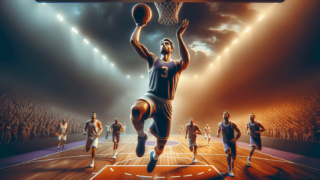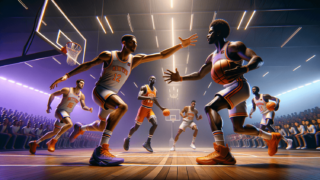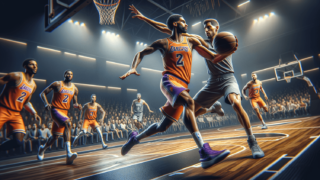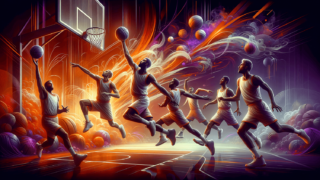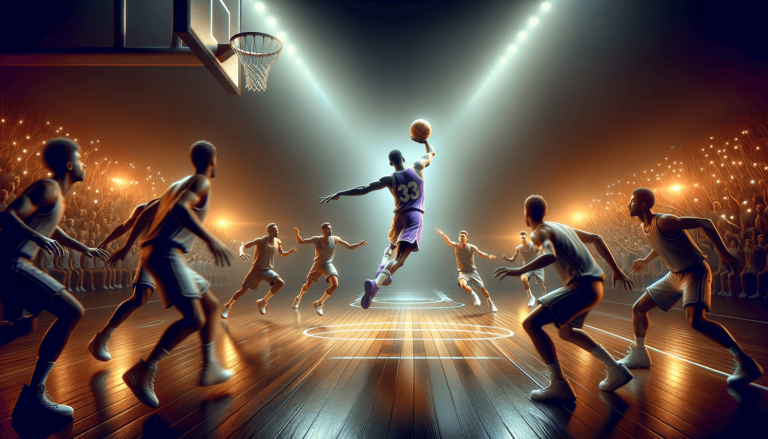
Are you ready to take your basketball knowledge to the next level? One mesmerizing skill that never fails to spark excitement in the game is the no-look pass. Today, we’ll dive deep into the basketball world to learn what distinguishes the no-look pass from a regular one, and why it’s such a stimulating and head-turning move. Join us as we break down the mechanics, tactics, and history of this remarkable play, and even uncover some tips that might help you incorporate the magic of the no-look pass into your own game!
What’s a No-Look Pass in Basketball?
A no-look pass in basketball is a skillful and deceptive move where a player passes the ball to a teammate without directly looking at them. This technique is employed to trick the defenders, making it difficult for them to anticipate the direction of the pass. The no-look pass not only adds an element of surprise to the game but also showcases the player’s spatial awareness, creativity, and advanced court vision.
The Origins of the No-Look Pass
While it is difficult to pin down the exact origin of the no-look pass, its widespread popularity in modern basketball can be attributed to a few iconic players who made it their signature move. Magic Johnson, Larry Bird, and Jason Williams are among the pioneers, while Steve Nash and Pete Maravich have also left a lasting impact on the art and widespread acceptance of the no-look pass. These players demonstrated how a perfect mix of skill, spontaneity, and daring could produce some truly memorable basketball highlights.
Why Use a No-Look Pass?
Catch Defenders Off Guard
One primary advantage of executing a no-look pass is that it makes the defending team’s job more challenging. By not showing any intent to pass, the passer can deceive defenders into anticipating a different play, thereby creating an opportunity for an open teammate to score. When the defenders are unsure about the passer’s next move, it creates confusion, and before they realize, a successful no-look pass may have already been completed.
Create Scoring Opportunities
The no-look pass can open up multiple scoring opportunities for a team. With opponents constantly second-guessing the passer’s intentions, it becomes easier to create and exploit gaps in the defense. A well-executed no-look pass can lead to more layups, dunks, and open shots, especially in fast-break situations, as the defenders won’t be ready or will be locked down by proper screening.
Show off Your Basketball Creativity
There’s no denying that the no-look pass adds a dash of flair and style to the game, helping to elevate the audience’s excitement. When a player seamlessly delivers a no-look pass, it showcases their heightened sense of court awareness, skill, and connection with teammates – making them a true basketball magician.
How to Perfect a No-Look Pass: Tips and Techniques
Develop Your Court Vision
To excel at performing a no-look pass, it is crucial to have an exceptional court vision. Being able to read the court and understand the offensive and defensive schemes will help improve your ability to anticipate how the play will unfold. Enhance your awareness by paying close attention to all players on the court, identify their positioning and movement, and mind your own mental map of everyone’s location. This awareness will make it easier to deliver a successful no-look pass when the opportunity arises.
Master Ball Control and Handling Skills
Adept ball-handling skills are a must for any player looking to execute the no-look pass. Become comfortable and confident with your dribbling abilities and practice different types of passes, such as bounce passes and chest passes. Developing a solid foundation in ball control and handling will give you the necessary skill set to perform a no-look pass seamlessly.
Strengthen Communication with Teammates
A successful no-look pass requires a strong understanding and synergy with your teammates. By nurturing good communication and rapport, your teammates will be able to predict your no-look pass and position themselves accordingly to receive it. Knowing your teammates’ tendencies, capabilities, and movement patterns will help you predict their positions on the court, making the art of the no-look pass a shared responsibility.
Practice, Practice, Practice
Perfecting the no-look pass takes time, commitment, and constant practice. Incorporate no-look passes into your regular training sessions and pick-up games, experimenting with different techniques and situations. As you progress, you’ll start to develop an intuitive understanding of when to use the no-look pass and how to finesse it effectively.
Notable No-Look Pass Experts
Many basketball legends have left their indelible mark on the no-look pass over the years. Here are some notable players who have consistently awed fans with their exceptional no-look passing skills:
Magic Johnson
Considered one of the best point guards in the history of the NBA, Magic Johnson has earned his place among the greats with his incredible vision, creativity, and passing ability. His legendary no-look passes have helped redefine the point guard position and cement Johnson’s reputation as one of basketball’s most dazzling playmakers.
Larry Bird
With an unparalleled ability to make each of his teammates better, Larry Bird’s no-look passes were a testament to his basketball intelligence and acute court awareness. His incredible passing skills and ability to anticipate his teammates’ positions made Bird’s no-look passes both entertaining and effective.
Jason Williams
Nicknamed “White Chocolate,” Jason Williams was known for his flashy style and highlight-reel-worthy no-look passes. With a seemingly unending arsenal of deceptive passes and a penchant for showmanship, Williams remains one of the most exciting players who have graced the NBA’s hardwood.
LeBron James
While the no-look pass is not a primary weapon in LeBron James’ arsenal, his exceptional court vision, athleticism, and high basketball IQ has seen him execute numerous jaw-dropping no-look passes throughout his illustrious career. James continues to impress both his teammates and opponents with remarkable passing ability.
Game Situations: When to Use the No-Look Pass
Fast Breaks
During a fast break, defenders often scramble, creating an ideal opportunity to surprise them with a no-look pass. As the defense transitions and reestablishes their positioning, a well-timed no-look pass can catch them off guard, leading to an easy basket for your team.
Pick and Roll
In pick and roll situations, a no-look pass enables the ball-handler to deceive the defenders and create scoring opportunities. Whether it’s slipping the pass to the rolling player or kicking out to an open shooter, incorporating a no-look pass in this situation can make it difficult for defenders to react, leading to a higher probability of success for your team.
Post Passing
When passing to a teammate in the post, using a no-look pass can help dupe the defenders who are closely guarding the perimeter. By not giving away your intention to pass, you allow your post player to establish a better position and make it difficult for the defenders to intercept the pass or double-team the post.
Conclusion
To sum it up, the no-look pass is an exciting and effective weapon in a basketball player’s arsenal. While it comes naturally to some, others need to work on their court vision, ball-handling, and communication to execute it perfectly. Like any other skill, practice and dedication are the keys to mastering the art of the no-look pass. If you aspire to baffle the opponents and dazzle the crowds like the legends of the game, get ready to embrace the challenge and elevate your basketball skills to new heights.
Defending Against No-Look Passes
While this article primarily focuses on the offensive prowess of the no-look pass, it is equally essential for defenders to understand how to counter this deceptive move. Successfully defending against a no-look pass requires keen observation, anticipation, and effective communication among teammates.
Study Opposing Players
The foundation of strong defense lies in knowing your opponents well. Study their habits, tendencies, and movements on the court. Focus on the players who are more likely to make no-look passes and observe their style and patterns. By understanding their preferences and favorite techniques, you can anticipate and react to their no-look passes more effectively.
Maintain Proper Defensive Positioning
Proper defensive placement on the court is crucial to thwart any offensive play, including a no-look pass. As a defender, stay on the balls of your feet, maintain a low stance, and be ready to react to any sudden movements. Be aware of your positioning relative to your teammates and your opponents to disrupt passing lanes and eliminate easy scoring opportunities.
Develop Team Defensive Communication
Effective communication among teammates is vital when defending against no-look passes. Alert your teammates to potential threats, calling out switches and the need for help defense as necessary. Good communication ensures that all members of the team stay in sync, actively monitor the floor, and work together to impede the offensive play.
Sharpen Your Reflexes
Quick reflexes are vital to reacting in time and intercepting no-look passes. Incorporate reaction-based drills into your training routine, focusing on hand-eye coordination, footwork, and agility. Enhancing your reflexes will not only boost your ability to defend against fast no-look passes but also contribute to your overall defensive prowess.
FAQ Section: No-Look Pass in Basketball
Get answers to some of the most common questions about the no-look pass and learn the nuances of this exciting and entertaining basketball move.
1. Can beginners use a no-look pass effectively?
Yes, beginners can effectively use a no-look pass with practice and effort. Initially, focus on mastering the basics of passing and ball control. As you gain experience, gradually incorporate no-look passes into your practice routine and pick-up games to develop the skill further.
2. Are there any risks involved in executing a no-look pass?
Though no-look passes can be highly effective when executed well, they can also carry the risk of turnovers if not performed accurately. Miscommunication with teammates or lack of court vision can lead to possession loss, leaving your team vulnerable to counter-attacks. Always weigh the risk versus reward before attempting a no-look pass in-game situations.
3. Can the no-look pass be used in both offense and defense?
Primarily, the no-look pass is an offensive move that creates scoring opportunities and catches the defense off guard. However, defenders can use the technique when making quick outlet passes, especially after securing a defensive rebound or making a clean steal.
4. How can I improve my court vision to execute no-look passes effectively?
Enhancing your court vision involves developing a more in-depth understanding of the game, directing attention to all players on the court, their positioning, and movement patterns. Watch game footage, analyze offensive and defensive schemes, and play in pick-up games to elevate your awareness and understanding of the game.
5. Are no-look passes effective in basketball video games?
In basketball video games, no-look passes are generally effective as they can create scoring opportunities and confuse virtual defenders. However, the efficiency of these passes in video games depends on the specific game mechanics and the skill level of the player-controlled character.
6. Is a no-look pass legal in all basketball leagues?
Yes, the no-look pass is a legal move in all basketball leagues, as long as it adheres to the general rules of passing. There is no specific regulation that prevents a player from executing a no-look pass, as it is simply a deceptive form of a standard bounce, chest, or overhead pass.
7. Can the no-look pass be effectively used in both half-court and full-court settings?
Absolutely, the no-look pass can be effective in both half-court and full-court settings. In half-court offenses, it can help create scoring opportunities in pick and roll, isolation, or post-play situations. On the other hand, in full-court scenarios, the no-look pass is often used during fast breaks to catch retreating defenders off guard.
8. How can I incorporate the no-look pass into my team’s offensive playbook?
Coaches and players can integrate the no-look pass into the team’s offensive playbook by developing situational plays that exploit defensive weaknesses. Work with your teammates to understand their preferred positions and movements, and create schemes that capitalize on their strengths. The key is to ensure that the team operates as a cohesive unit and is on the same page while executing the no-look pass play.
9. Are there any skill prerequisites to master the no-look pass?
Before attempting the no-look pass, aspiring players should primarily focus on developing fundamental basketball skills such as dribbling, passing, shooting, and court awareness. Having a strong foundation in these areas will enable you to effectively learn and execute the no-look pass with greater consistency and success.
10. Is the no-look pass only for point guards, or can other positions utilize it as well?
Though the no-look pass is more commonly associated with point guards, players at any position can utilize it effectively. Forwards and centers with good ball-handling and passing skills can also take advantage of the no-look pass to create unexpected scoring opportunities for their teammates.
Featured Posts
- No pillar pages found.
